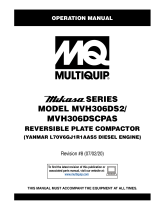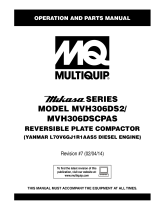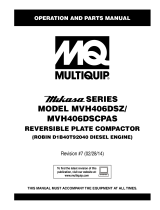
CR5 1
Operating and
Maintenance Manual
CR 5
0116251

2 CR5

CR5 3
Table of contents
Introduction 4
Safety guidelines 5
Graphic presentation 8
Device description 9
Technical data 10
Activities prior to starting work 12
Starting 13
Compacting 14
Shutting down 14
Maintenance overview 15
Maintenance work 16
Operating uids and ll levels 19
Troubleshooting 19
Measures to be taken if stored for long periods 20
Contact addresses 23

4 CR5
Introduction
This operating and maintenance manual is designed to facilitate familiarization with your soil
compactor, and enable you to maintain the compactor and use it in accordance with the proper
application possibilities.
When complying with the instructions in the operating and maintenance manual you help avoid
hazards, reduce repair and downtime costs, and increase the reliability and service life of your
compactor.
This operating and maintenance manual must always be available at the implementation site of
the soil compactor.
If needed you can obtain additional information from your authorized WEBER dealer, or you can
obtain information from one of the contact addresses on the last page.
The valid conformity declaration is enclosed with every machine delivery.
You can obtain information on the assembled Hatz-Diesel engine at www.hatz-diesel.com

CR5 5
Safety guidelines
General
All safety instructions must be read and complied with, non-compliance results in
- Danger to life and limb of the user
- Impairments to the machine or other property.
In addition to the operating manual the binding accident prevention guidelines in the country where
the compactor is used must be complied with.
Proper use
The soil compactor should only be used in technically faultless condition, as intended, in a safety-
conscious and hazard-conscious manner, in compliance with the instructions in the operating
manual. Malfunctions that impair safety must be eliminated without delay.
The CR 5 soil compactor is designed exclusively for compacting
- Sand
- Gravel
- Crushed rock
- Semi-cohesive mixed material
- Concrete paving stone
Any other use of the soil compactor is considered to be improper use for which the owner shall be
exclusively responsible. All liability is rejected if damage occurs due to non-compliance with this
provision. This risk is borne solely by the user.
Easily foreseeable misuse
Any use for which the machine is not intended.
Driving
Soil compactors should only be driven by suitable personnel at least 18 years of age, Drivers must be
instructed in how to guide the compactor by the owner or by owner’s assigned personnel.
The machine operator must comply with trac regulations. If instructions that aect safety are given
by third persons, then the operator must be authorized to reject these instructions.
Unauthorized persons are forbidden from being in the area of the soil compactor during the
compacting process.
Protective equipment
This machine is capable of exceeding the permissible sound level of 80 dB(A). The owner might also
face additional dangers when using the machine. Precautionary action must, therefore, be taken.
Protective equipment includes:
Ear protection
Hard hat
Safety shoes
Protective gloves

6 CR5
Prior to maintenance and repair work
Only use original Weber spare parts to ensure reliable and safe operation for maintenance or repair
work.
For repair, maintenance, or inspection work the engine of the compactor must be safeguarded
against unintentional starting.
All pressurized lines, particularly hydraulic lines and lines of the injection system of the drive motor
must be depressurized before performing maintenance or repair tasks.
For maintenance and repair tasks the compactor must be parked on a level and stable substrate and
must be secured from rolling o or tipping over.
Heavy components and subassemblies must be secured on hoisting machines with adequate bearing
capacity when they are replaced. Ensure that no hazard exists related to the raised components or
subassemblies.
Do not position yourself or work under suspended loads.
Operation under dicult conditions
Never inhale the exhaust gas; it contains carbon monoxide, a colorless and odorless gas that is
extremely hazardous, which if inhaled even briey can cause unconsciousness and death.
Never operate the engines in enclosed areas or in areas that are poorly ventilated (tunnels, caves,
etc.) Exercise particular caution when operating the engine in the vicinity of people and livestock.
Hydraulic hose lines must be checked at regular intervals in accordance with standard engineering
practice, or they must be replaced at appropriate intervals, even if no signs of safety-relevant defects
are present.
Adjusting tasks, maintenance tasks, and inspection tasks must be executed on schedule as specied
in this operating and maintenance manual. These activities should only be executed by instructed
personnel.
Operation
Prior to starting work the owner of the compactor must be familiar with the work environment. The
work environment includes obstacles in the work and trac area, the bearing capacity of the ground,
as well as the necessary safeguarding of the construction site in the area adjacent to public trac;
and it includes compliance with trac regulations.
The soil compactor should only be operated when the protective xtures are mounted. The protective
xtures must all be in functional condition.
At least once per shift the compactor must be checked for apparent defects. If there are apparent
defects then operation of the compactor must be stopped immediately and the responsible person
must be informed. Prior to restarting, compactor malfunctions that have occurred must be corrected.
If lubricating oils and fuel come into contact with skin, they can cause skin cancer. Upon contact
with the skin, clean aected skin with suitable cleaning agent without delay.

CR5 7
Inspection
Compactors must be inspected in accordance with appropriate implementation conditions and
operating conditions, as needed; however an inspection to ensure operationally safe status must be
performed by an expert at least once a year. The results of the inspection must be recorded in writing
and must be stored until the next inspection.
Cleaning work
Prior to cleaning the compactor with a high-pressure cleaner, protect all accessible energized
switches, cable connections, etc. against water penetration by masking them o.
Cleaning tasks should only be executed in areas that suitable and approved for this purpose (oil
separator).
Disposal
All operating uids and auxiliary materials must be disposed of in an environmentally-compatible
manner, in accordance with country-specic regulations.
Important information for operating and maintenance personnel is marked by pictograms.
Warning against irritants or materials hazardous to health
Warning against a hazardous place
Warning against a suspended load
Wear ear protection
General regulation
Environmental protection
Hard hat
Safety shoes
Protective gloves

8 CR5
Graphic presentation
Overall view CR 5
1 Engine
2 Drive lever
3 Manual guidance rod
4 Lifting ring
5 Base plate
6 Protective frame
7 Exciter
8 Gas lever
9 Attachment plates
3
4
6
2
4
5
7
8
9
1
10
10 Wear ear protection (Stickers)

CR5 9
Device description
The CR 5 compactor is used for road building and landscaping compaction tasks.
Propulsion
The compactor is propelled by an air-cooled Hatz diesel engine.
Force is transferred to the exciter mechanically via a V-belt.
Operation
Start the Hatz diesel engine with the attached reversing starter.
After starting, vibration is switched on via the centrifugal clutch attached to the engine. Use the
gas lever to vary the engine rpm between idle and full throttle.
Forward and reverse is steplessly controlled via the handle attached to the manual guidance rod.

10 CR5
Technical data
CR 5
Weight
Operating weight CECE in kg (basic device) 281
Dimensions
Overall length in (in mm) 1520
Overall width/with attachment plates (in mm) 550/700
Height with folded manual guidance rod (in mm) 1070
Base plate length (base in mm) 250
Pressure surface (in mm) 250x550
Propulsion
Engine manufacturer Hatz
Type 1 B 30
Performance at operating speed in acoordance with ISO 3046-1 (kW) 4,6
Combustion process 4-stroke diesel
Speed 3000
Drive speed (ground-dependent in m/min) 20
Incline capacity (ground-dependent in %) 35
Area capacity/with attachment plates (in m²/h) 660/840
Vibration
system Two-wave vibrator
Drive concept Mechanical
Frequency (in Hz) 75
Centrifugal force (in kN) 42
CR 5
Noise emissions in accordance with 2000/14/EC
Sound pressure level LPA ascertained in accordance with EN
500, in dB (A) 96
Sound power level LPA ascertained in accordance with EN
ISO 3744 and EN 500, in dB (A) 108
Vibration values
Root-mean-square acceleration value for hand-arm
vibration ascertained in accordance with EN 500 in m/s² 3,3
In accordance with directive 2006/42/EC,
complying with the vibration values is
the owner‘s responsibility.

CR5 11
1Description 2 TYPE
.................................................... ...................................................
3 Serial-Number 4 Year of construction
.................................................... ....................................................
5 Mass 6 Rated power KW
2
1
3 4
56

12 CR5
Transport
Fit the crane hook into the hinged lifting ring (1) and lift the
machine onto the desired means of transport. 1
Only use lifting machines with a minimum bearing ca-
pacity of 350 kg.
Arrest the manual guidance rod (1) with the spring bolt (2). 1
2
1
Adjust the desired work height of the manual guidance rod
with the set screw (1).
Adjusting the manual guidance rod
Open the cover (1), unscrew and remove the gas cap (2),
check the ll level, if necessary top o with clean diesel fuel
to the lower edge of the ller neck.
The correct oil level is between the min. and max. marks.
Checking the engine oil level
Pull the oil dip stick out of the crankcase.
Checking the fuel level
min: max
1
2
Activities prior to starting work
When transporting the soil compactor on a vehicle,
secure it with suitable restraints.
Do not step under suspended loads.
For work at the fuel system, have a suitable re-extin-
guishing agent at the ready.
Fire, naked light, and smoking is forbidden!

CR5 13
Starting
Bring the gas lever into full-throttle position.
Check the hydraulic oil level when the machine is at operating
temperature. The correct oil level is reached when the oil is in
the middle of the view glass.
Tighten the screws (1) of the attachment plates (2) with a
torque of 310 NM.
Checking the hydraulic uid level
Mounting the attachment plates
Mounting the Poly pad
Fasten the Poly pad with holder, screws, spring-lock washers
and nuts on the base plate front and rear.
Ensure that the Poly pad rests under the base plate.
Slowly tighten the handle (1) of the reversing starter (2) until
resistance is noticeable.
Allow the handle (1) to glide back into the initial position, and
then forcefully and completely pull it through with both hands.
Allow the engine warm up for a few minutes.
If ambient temperatures are below minus 5 degrees
Celsius comply with the instructions in the operating
manual provided by the engine manufacturer.
1
2
1
2

14 CR5
Shutdown
Bring the gas lever (1) into idle position.
Press the switch-o button (1).
Compacting
Control drive speed and direction of travel with the handle
(1). 1
Bring the gas lever (1) into full-throttle position.
1
The engine can only be switched o via the switch-o
button!
1
1
Only run machine within reach of the manual guidance
rod.
During breaks—even if they are short—the machine
must be shut down.
Parked devices that represent an obstacle must be
safeguarded against conspicuously.

CR5 15
Maintenance overview
In addition to the aforementioned maintenance work, the engine manufacturer’s regulations must
be complied with.
Work must be carried out using regulation tools and the operating and maintenance manual must
be complied with for all work.
All maintenance work: select a collection vessel that is large enough to prevent oil from spilling onto
the ground. Dispose of waste oil in an environmentally friendly manner (regulation on waste oils).
Dispose of oils, oil-soaked cloths, and parts replaced and smeared with oil in an environmentally
friendly manner.
If lubricating oils and fuel come into contact with skin, they can cause skin cancer. Upon contact
with the skin, clean aected skin with suitable cleaning agent without delay.
If accessible during maintenance, check the condition and stability of all screws.
Maintenance interval Maintenance
point Maintenance activity
After the rst 25
operating hours Engine
- Change engine oil
-Check valve clearance,
adjust if necessary
-Re-tighten all accessible
threaded connections
Every 8 operating
hours/daily Air lter -
Clean air lter insert,
check for damage,
replace if necessary
Every 150 operating
hours/every 6 months
Engine - Change engine oil
-Change the fuel lter
-Change oil lter
Every 150 operating
hours/every year
Transmission - Change oil
Exciter - Change oil
Every 250 operating
hours Engine - Check valve clearance,
adjust if necessary

16 CR5
Cleaning the engine oil lter
Changing the engine oil
1
Open the cover lid (1) of the oil ller neck.
1
When working in the area of the engine compartment
there is danger of burn injury!
Screw the oil drain pipe (1) onto the engine drain valve and
drain o the oil.
After emptying completely, unscrew the oil drain pipe
from the drain valve and ll with oil in accordance with the
specication.
Loosen the screw (1) approximately 5 revolutions.
Pull the oil lter (1) out of the motor compartment.
Blow out the oil lter (1) from inside to outside with
compressed air.
Lightly oil the sealing rings (2) on both sides of the oil lter.
Check sealing rings (2) for damage and rm seat, replace
the oil lter if there is damage.
Press the oil lter into the crankcase until the stop.
Prior to tightening the screws ensure that the tension
springs rest on the oil lter with both ends „1“.
1
Drain engine oil.
Maintenance work
Only drain engine oil when at operating temperature.
Danger of scalding due to hot oil.
Danger of scalding due to hot oil.
Only drain engine oil when at operating temperature.

CR5 17
Cleaning/changing air lter cartridges
Unscrew the air lter cover (1).
Remove the air lter insert (1) from the air lter enclosure
Clean the air lter insert in accordance with theguidelines
provided by the engine manufacturer, or replace if there is
extreme fouling.
1
1
Changing the fuel lter
Pull the fuel line (2) o the fuel lter (1) on both sides.
Replace the lter with a new lter element.
2
1
If lubricating oils and fuel come into contact with skin,
they can cause skin cancer. Upon contact with the
skin, clean aected skin with suitable cleaning agent
without delay.
Dispose of oils, oil-soaked cloths, and parts replaced and
smeared with oil in an environmentally friendly manner.

18 CR5
Changing the oil in the exciter
Remove the oil drain screw (1) and drain oil.
To ll - tilt the machine slightly and ll with fresh oil through
the drain opening in accordance with the ll level table.
Checking the V-belt
Remove the V-belt guard (1).
Check the V-belt (1) for cracks, damaged anks, and wear.
If there is excessive wear - replace the V-belt as specied in
the repair manual.
1
1
1
All maintenance work: select a collection vessel that is
large enough to prevent oil from spilling onto the ground.
Dispose of waste oil in an environmentally friendly man-
ner (regulation on waste oils).
Dispose of oils, oil-soaked cloths, and parts replaced
and smeared with oil in an environmentally friendly
manner.

CR5 19
Operating uids and ll levels
Troubleshooting
Subassembly Fuel Quantity
Summer Winter CR 5
Quality
Engine
Engine oil SAE 10 W 40 1,1 l
(-10 ~ + 50 °C)
API - CD CE-CF-CG
or SHPD
or CCMC - D4 - D5 - PD2
Diesel 4,6 l
Diesel in accordance with DIN
51601-DK
Fuel tank or BS2869-A1/A2
or STM D975-1D/2D
Fully-synthetic transmission uid
API GL-5/GL-4
Vibrator First lling Fuchs Titan SINTOPOID 0,75 l
LS SAE 75W-90
Switching
Transmission uid DEXRON II-D-
ATF
First lling as necessary
Fuchs Titan ATF 3000
or equivalent
Fault Possible cause Remedy
Soil compactor does not
start Operating error Execute start process as
prescribed
Lack of fuel Check the fuel level
Fuel lter fouled Change the fuel lter
Air lter fouled Clean/change air lter
cartridge
No vibration / no forward
motion or insucient
forward motion
Vibrator V-belt
defective Change vibrator V-belt
Soil compactor does not
switch
Wrong hydraulic oil
level in the manual
guidance rod
Check oil level
Correct oil level

20 CR5
Measures to be taken if stored for long periods (longer than one month)
If the machine is to be stored for longer than six months, then contact the Weber service organi-
zation to discuss additional measures.
Entire soil compactor
- Clean thoroughly
- Check watertight
- If there are leaks, correct defect
Fuel tank
-
Empty fuel and ll with clean fuel
up to the lower edge of ller neck
Engine
-Check oil level, if necessary ll to
upper oil-level mark
-Check air lter, clean, replace if
necessary
-Check fuel lter, change if
necessary
All bare parts/accelerator/accelerator
control cable/fastening bolts - Oil/grease
Starter battery (if there is one)
- Remove battery
-
Check acid level; if it is too low,
ll with distilled water up to max.
mark of the battery
-Store above freezing in a storage
room
-Attach permanent charger
Page is loading ...
Page is loading ...
Page is loading ...
Page is loading ...
/


















